FCGR3A
-
Official Full Name
Fc Fragment Of IgG, Low Affinity IIIa, Receptor (CD16a)
-
Overview
This gene encodes a receptor for the Fc portion of immunoglobulin G, and it is involved in the removal of antigen-antibody complexes from the circulation, as well as other other antibody-dependent responses. This gene (FCGR3A) is highly similar to another nearby gene (FCGR3B) located on chromosome 1. The receptor encoded by this gene is expressed on natural killer (NK) cells as an integral membrane glycoprotein anchored through a transmembrane peptide, whereas FCGR3B is expressed on polymorphonuclear neutrophils (PMN) where the receptor is anchored through a phosphatidylinositol (PI) linkage. Mutations in this gene have been linked to susceptibility to recurrent viral infections, susceptibility to systemic lupus erythematosus, and alloimmune neonatal neutropenia. Alternatively spliced transcript variants encoding different isoforms have been found for this gene. -
Synonyms
CD 16; CD 16a; CD16A; CD16a antigen; CD16B; CD16b antigen; Fc fragment of IgG; Fc fragment of IgG low affinity IIIa receptor (CD16); Fc fragment of IgG, low affinity III, receptor (CD16); Fc fragment of IgG, low affinity IIIa, receptor (CD16); Fc fragment of IgG, low affinity IIIa, receptor (CD16a); Fc fragment of IgG, low affinity IIIb, receptor (CD16b); Fc fragment of IgG, low affinity IIIb, receptor for (CD16); Fc gamma R3; Fc gamma receptor IIIA; Fc gamma receptor IIIb (CD 16); Fc gamma RIII alpha; Fc gamma RIII; Fc gamma RIII beta; Fc gamma RIIIa; Fc gamma RIIIb; Fc of IgG; Fc-gamma receptor III2 (CD 16); Fc-gamma receptor III2 (CD16); Fc-gamma receptor IIIb (CD16); Fc-gamma RIII; Fc-gamma RIII-alpha; Fc-gamma RIIIa; FCG 3; FCG3; FCG3A_HUMAN; FCgammaRIIIA; FCGR 3; FCGR 3A; FCGR3; FCGR3A; FCGR3A protein; FCGRIII; FcR 10; FcR-10; FcR10; FcRIII; FcRIIIa; IGFR 3; IGFR3; IgG Fc receptor III 1; IgG Fc receptor III 2; IgG Fc receptor III-2; immunoglobulin G Fc receptor III; Low affinity IIIa receptor; Low affinity immunoglobulin gamma Fc region receptor III A; Low affinity immunoglobulin gamma Fc region receptor III-A; Low affinity immunoglobulin gamma Fc region receptor IIIB; neutrophil-specific antigen NA;
- Recombinant Proteins
- Cell & Tissue Lysates
- GMP Proteins
- Protein Pre-coupled Magnetic Beads
- Antibody
- Cynomolgus
- Homo sapiens (Human)
- Human
- Rat
- CHO
- CHO Cells
- E.coli
- E.coli expression system
- HEK293
- HEK293 cells
- HEK293F
- HEK293T
- Human Cell
- Human cells
- In Vitro Cell Free System
- Insect Cell
- Mammalian cells
- Mouse
- Wheat Germ
- C
- 6×His
- His
- Avi
- Fc
- DYKDDDDK
- Flag
- GST
- His (Fc)
- His(C
- ter)
- His|Avi
- His|GST
- Myc
- DDK
- N/A
- N
- Tag Free
- Background
- Quality Guarantee
- Case Study
- Involved Pathway
- Protein Function
- Interacting Protein
- FCGR3A Related Articles
What is FCGR3A protein?
FCGR3A (Fc gamma receptor IIIa) gene is a protein coding gene which situated on the long arm of chromosome 1 at locus 1q23. This gene encodes a receptor for the Fc portion of immunoglobulin G, and it is involved in the removal of antigen-antibody complexes from the circulation, as well as other other antibody-dependent responses. The receptor encoded by this gene is expressed on natural killer (NK) cells as an integral membrane glycoprotein anchored through a transmembrane peptide, whereas FCGR3B is expressed on polymorphonuclear neutrophils (PMN) where the receptor is anchored through a phosphatidylinositol (PI) linkage. The FCGR3A protein is consisted of 254 amino acids and its molecular mass is approximately 29.1 kDa.
What is the function of FCGR3A protein?
FCGR3A is one of the main receptors on natural killer (NK) cells, able to recognize and bind to the Fc region of IgG antibodies. When IgG antibodies bind to target cell surface antigens, FCGR3A triggers NK cells to release toxic molecules. FCGR3A not only participates in the ADCC effect, but also regulates the function of other immune cells by binding to IgG antibodies. FCGR3A also plays an important role in the inflammatory response.
FCGR3A Related Signaling Pathway
FCGR3A binds to the Fc portion of the IgG antibody through its extracellular region, triggering downstream signal transduction events. This binding results in the aggregation and crosslinking of FCGR3A, which activates its associated immune receptor tyrosine activation motifs (ITAMs). Subsequently, non-receptor tyrosine kinases such as Syk (spleen tyrosine kinase) and Lyn are activated, triggering a cascade of phosphorylation events. This further activates a variety of intracellular signaling molecules, such as the PI3K/Akt, MAPK/ERK, and NF-κB pathways. These signaling pathways ultimately lead to the release of inflammatory mediators, respiratory bursts, degranulation, and the execution of ADCC (antibody dependent cytotoxicity) effects, which mediate the clearance of pathogens or tumor cells.
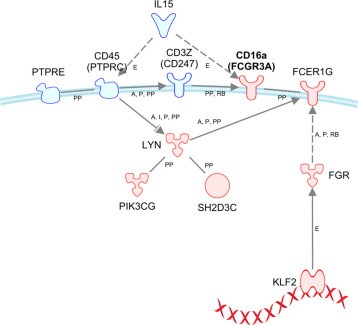
Fig1. CD16a signaling network of the ABMR-associated and -selective transcripts. (J M Venner, 2015)
FCGR3A Related Diseases
FCGR3A gene polymorphism is closely related to the occurrence and development of a variety of autoimmune diseases, such as rheumatoid arthritis, systemic lupus erythematosus, scleroderma and so on. FCGR3A is also involved in regulating the host's immune response to pathogens. For example, certain bacterial or viral infections may cause an excessive inflammatory response, leading to tissue damage. In addition, the variation of FCGR3A gene is also closely related to the occurrence and development of a variety of tumors.
Bioapplications of FCGR3A
There are multiple genotypes of FCGR3A that are associated with an individual's susceptibility to certain diseases. Studying these genotypes will help to implement personalized medicine. Certain drugs may affect the function of FCGR3A, thereby altering the immune response. By studying these interactions, the safety of the drug can be better assessed.
High Purity
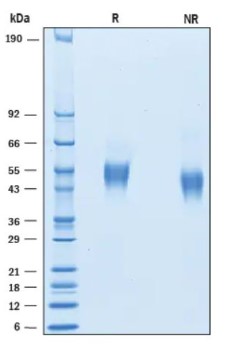
Fig1. SDS-PAGE (FCGR3A-052H) (PROTOCOL for western blot)
High Bioactivity
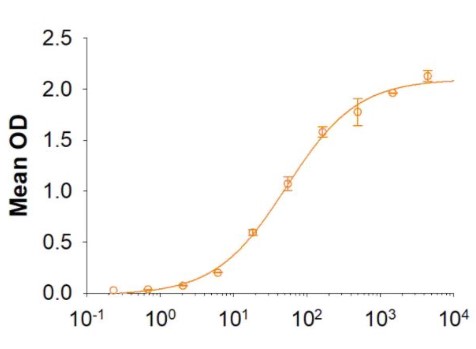
Fig2. Activity Data. (FCGR3A-052H)
Case Study 1: Anil K Chauhan, 2017
Recognition of Ab-opsonized pathogens by immune cells triggers both TLR and Fc receptor signaling. Fc receptors endocytose modified nucleic acids bound to Abs and deliver them to endosomes, where they are recognized by nucleic acid-sensing TLRs (NA-TLRs). The researchers show that in CD4+ T cells, NA-TLRs, TLR3, TLR8, and TLR9 are upregulated by FcγRIIIa-pSyk cosignaling and localize with FcγRIIIa on the cell surface. TLR9 accumulates on the cell surface, where it recognizes CpG oligonucleotide 2006. Subcellular location of NA-TLRs is a key determinant in discriminating self versus viral nucleic acid. Hydroxychloroquine used for treating systemic lupus erythematosus and a Syk inhibitor blocked NA-TLR localization with FcγRIIIa. Engaging TLR9 with CpG oligonucleotide contributes to the development of IL17A+ and IL-21+ populations. RNA-sequencing analysis showed upregulation of proinflammatory cytokines, NF-κB signaling, and heat shock protein pathway RNA transcripts. These data suggest a role for FcγRIIIa-pSyk cosignaling in modulating NA-TLR responses in human CD4+ T cells by affecting the amounts and cellular distribution.
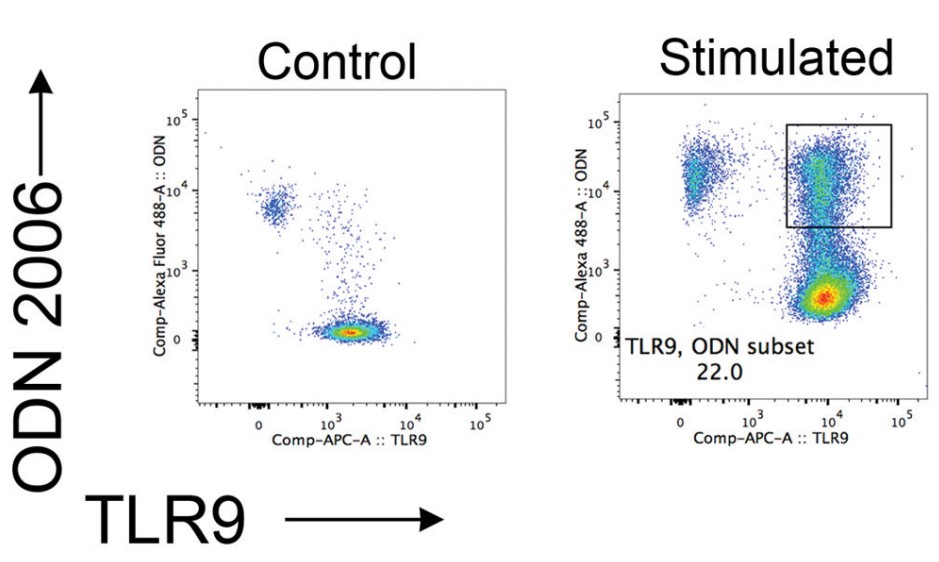
Fig1. Flow staining in P116 cells upon FcγRIIIa-pSyk costimulation shows binding of Alexa Fluor 488- CpG ODN 2006 within 10 minutes in TLR9+ (22%) cells.
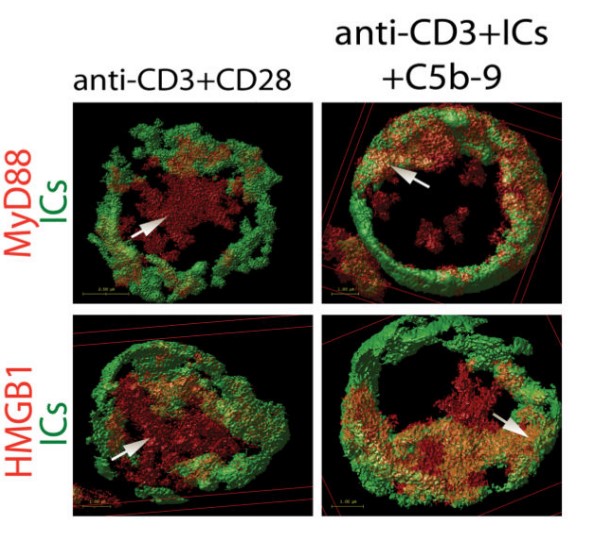
Case Study 2: Per Flodbring Larsson, 2022
Low-affinity immunoglobulin gamma Fc region receptor III-A (FcγRIIIa) is a cell surface protein that belongs to a family of Fc receptors that facilitate the protective function of the immune system against pathogens. However, the role of FcγRIIIa in prostate cancer (PCa) progression remained unknown. PCa patients with an elevated level of FcγRIIIa expression had poorer biochemical recurrence (BCR)-free survival compared with those with lower FcγRIIIa expression, suggesting that FcγRIIIa is of clinical importance in PCa. We demonstrated that overexpression of FcγRIIIa increased the proliferative ability of PCa cell line C4-2 cells, which was accompanied by the upregulation of androgen receptor (AR) and phosphatidylinositol-4-phosphate 5-kinase alpha (PIP5Kα), which are the key players in controlling PCa progression. Conversely, targeted inhibition of FcγRIIIa via siRNA-mediated knockdown or using its inhibitory antibody suppressed growth of xenograft PC-3 and PC-3M prostate tumors and reduced distant metastasis in xenograft mouse models. Similarly, inhibition of PIP5K1α decreased FcγRIIIa expression in PCa cells. FcγRIIIa physically interacted with PIP5K1α and AR via formation of protein-protein complexes, suggesting that FcγRIIIa is functionally associated with AR and PIP5K1α in PCa cells.
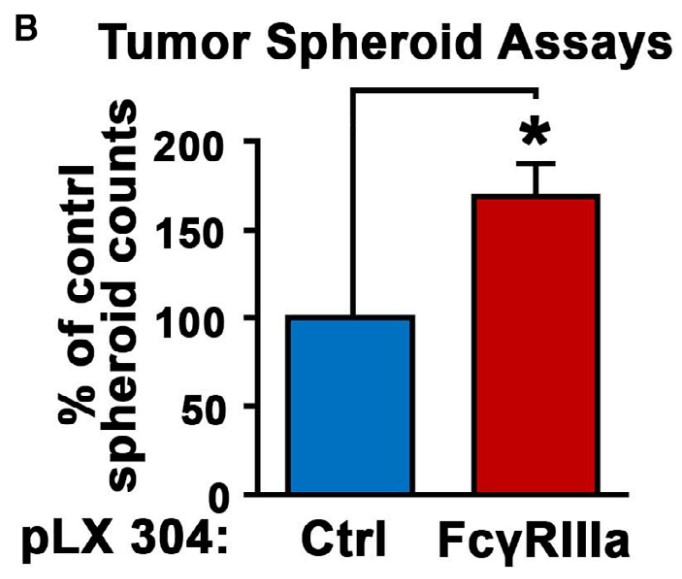
Fig3. The effect of FcγRIIIa overexpression on the tumorigenic ability of C4-2 cells was assessed using tumor-spheroid formation assays.
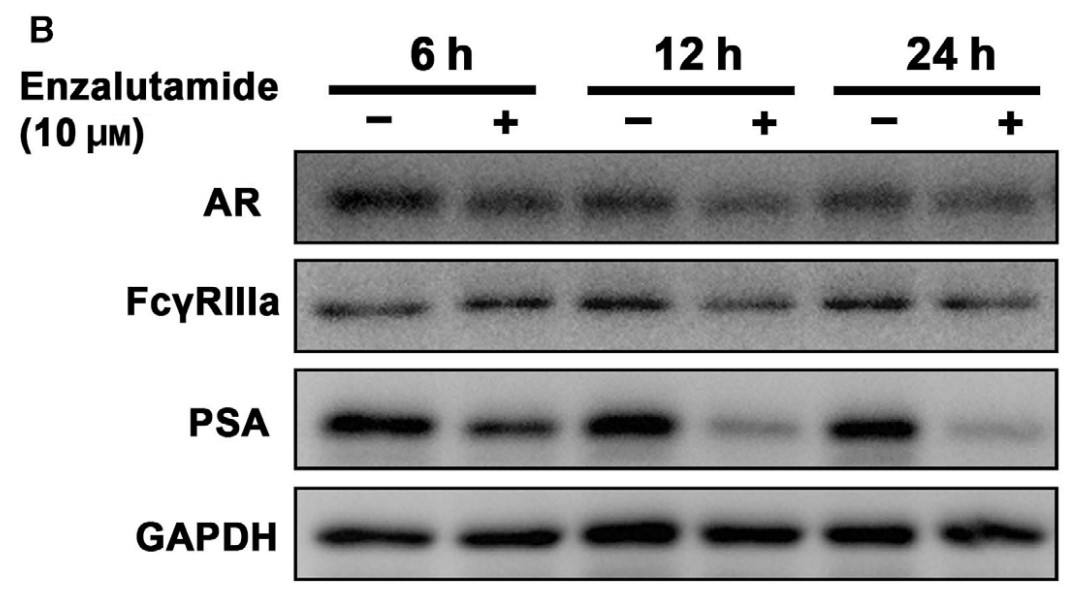
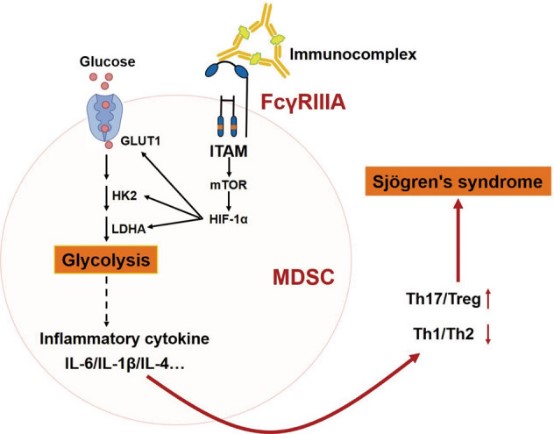
Fig1. Schematic representation of FcγRIIIA activationinducing MDSCs to alter CD4+ T cell subsets by enhancing glycolysis in Sjögren syndrome. (Jingjing Qi, 2023)
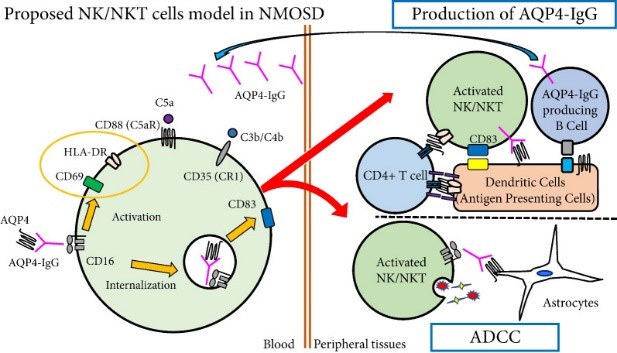
Fig2. Graphical hypothesis of NK/NKT cells model in NMOSD. (Shuhei Nishiyama, 2022)
FCGR3A involved in several pathways and played different roles in them. We selected most pathways FCGR3A participated on our site, such as Phagosome, Osteoclast differentiation, Natural killer cell mediated cytotoxicity, which may be useful for your reference. Also, other proteins which involved in the same pathway with FCGR3A were listed below. Creative BioMart supplied nearly all the proteins listed, you can search them on our site.
| Pathway Name | Pathway Related Protein |
|---|---|
| Phagosome | FCGR4;TUBB6;ATP6V1B2;HLA-DMA;FAM49BA;TUBA1L;FCGR3;ITGB3;TUBB1 |
| Osteoclast differentiation | SQSTM1;TGFB1;MAPK8;PLCG2;TNF;TRAF2;NOX1;FOSL1;MAPK13 |
| Natural killer cell mediated cytotoxicity | PIK3R1;SYK;FYN;Raet1a;KIR3DL1;SAMD3;MAP2K2;IFNA2;ARAF |
| Fc gamma R-mediated phagocytosis | PIP5K1B;PIK3R1;LAT;FCGR1;INPP5D;LIMK2;MAPK1;PRKCG;LYN |
| Leishmaniasis | IL12A;NFKBIB;FCGR1A;HLA-DQB1;HLA-DRB5;TLR4;IL1B;HLA-DPA1;ITGB1 |
| Staphylococcus aureus infection | HLA-DRB1;FPR3;HLA-DQA1;C1S;HLA-DMA;MBL1;DSG1A;FCGR1A;FCGR1 |
| Tuberculosis | PLK3;HSPA9;IFNB1;IFNGR2;CARD9;TNFRSF1A;ITGAX;IL6;BCL2 |
| Systemic lupus erythematosus | HIST1H2AO;H2-AB1;ACTN1;H3F3C;HIST1H4G;HIST1H2BQ;HLA-DRB5;HLA-DQA2;TROVE2 |
FCGR3A has several biochemical functions, for example, IgG binding. Some of the functions are cooperated with other proteins, some of the functions could acted by FCGR3A itself. We selected most functions FCGR3A had, and list some proteins which have the same functions with FCGR3A. You can find most of the proteins on our site.
| Function | Related Protein |
|---|---|
| IgG binding | cgr2b;FCGR2C;FCGR1A;FCGR3B;FCGR3A;FCGRT;CD247L;FCGR2A;FCGR1B |
FCGR3A has direct interactions with proteins and molecules. Those interactions were detected by several methods such as yeast two hybrid, co-IP, pull-down and so on. We selected proteins and molecules interacted with FCGR3A here. Most of them are supplied by our site. Hope this information will be useful for your research of FCGR3A.
drozitumab; FCGR1A; ZBTB25; q81sn0_bacan
- Q&As
- Reviews
Q&As (7)
Ask a questionFCGR3A activates immune cells and mediates phagocytosis, aiding in the clearance of pathogens and antibody-coated targets.
FCGR3A is key in antibody-dependent cellular cytotoxicity, crucial for the effectiveness of certain cancer immunotherapies.
Genetic variations in FCGR3A influence responses to monoclonal antibody treatments, affecting treatment efficacy.
FCGR3A helps regulate the immune system's balance between activation and tolerance, preventing overactive immune responses.
Changes in FCGR3A function or expression can influence vaccine efficacy, impacting immune system responses to vaccination.
FCGR3A plays a role in the inflammatory response to infections, contributing to pathogen clearance and immune regulation.
FCGR3A expression impacts the development and severity of autoimmune diseases by modulating immune responses.
Customer Reviews (3)
Write a reviewOutstanding protein-protein interaction studies, boosts our experiments.
Swift protein quantification, improves data reliability.
Expertise in peptide synthesis, accelerates our peptide-based projects.
Ask a Question for All FCGR3A Products
Required fields are marked with *
My Review for All FCGR3A Products
Required fields are marked with *


